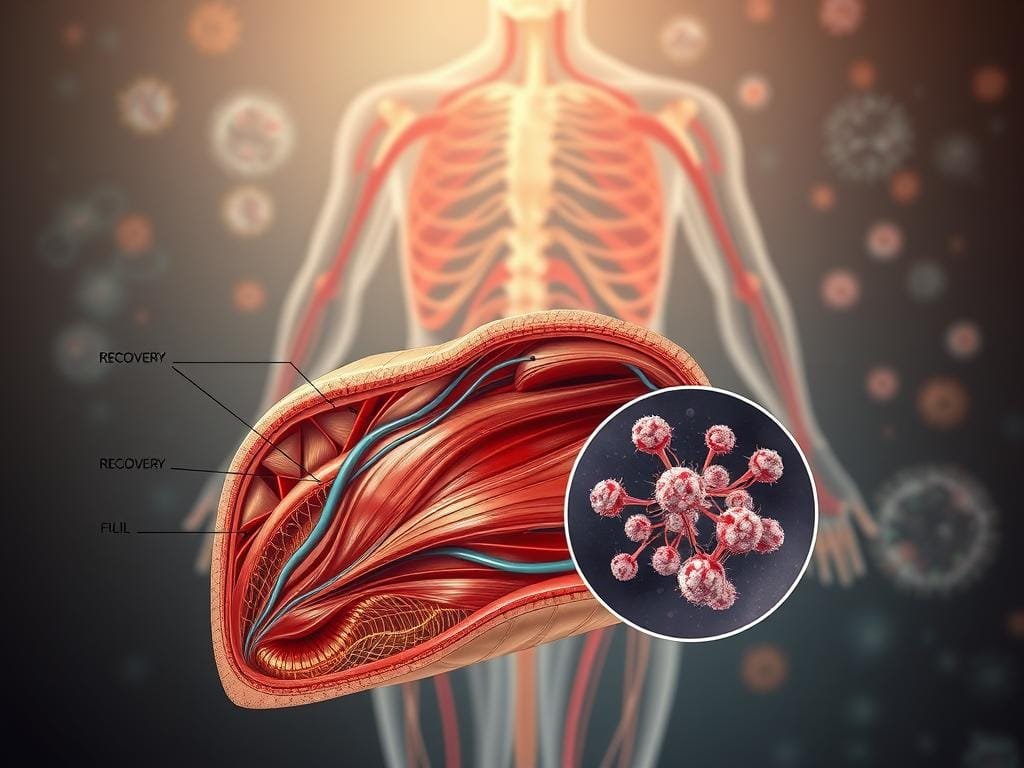Athletes often push their bodies to the limit. But it’s during rest that the real magic happens. Recovery is key for better physical skills and health. Did you know not enough rest can cut athletic performance by 20-30% in just a few days?
Good recovery science helps restore energy, fix muscle tissue, and refresh the nervous system. By learning about evidence-based recovery, you can make your rest periods better. This leads to top athletic performance.
Table of Contents
Key Takeaways
- Athletes can see a big drop in performance without enough rest.
- Recovery means getting energy back, fixing muscles, and refreshing the nervous system.
- Using evidence-based recovery methods can boost athletic performance.
- Getting rest right is vital for overall health and peak performance.
- Knowing recovery science helps athletes customize their rest times.
Understanding Recovery in Athletics
Recovery in sports is complex, involving many physical and mental steps. It’s not just about resting. It’s an active process that helps your body fix and get stronger after hard training or games.
What Is Recovery?
Recovery is when your body heals and gets better after hard work. It’s key for better performance because it lets muscles fix and grow back. Good recovery plans can make you perform better and lower injury risks.
Types of Recovery: Active vs. Passive
Recovery can be active or passive. Active recovery means doing light exercises like cycling or swimming after a workout. This boosts blood flow to muscles, helping get rid of waste.
Passive recovery means resting or doing very little. It’s vital for muscles to fully heal and grow back. Whether to choose active or passive recovery depends on how hard you’ve been training and what you need personally.
The Importance of Recovery for Athletes
Recovery is vital for athletes because it affects their performance and health. Good recovery lets muscles fix, energy stores get filled up, and your body adapt to training.
| Recovery Aspect | Description | Benefits |
|---|---|---|
| Muscle Repair | Repair of muscle fibers damaged during exercise | Enhanced strength and performance |
| Energy Replenishment | Replenishment of energy stores depleted during exercise | Improved endurance and reduced fatigue |
| Adaptation | Adaptation to the demands of training and competition | Better performance and resilience |
By knowing and using good recovery methods, you can reach your best in sports.
The Physiological Aspects of Recovery
Understanding the recovery process is key for athletes wanting to improve their performance. Recovery involves many physiological processes that help the body fix and adapt after exercise.

Muscle Repair and Growth
Muscle repair and growth are vital parts of recovery. After hard exercise, muscles get micro-tears, causing inflammation and damage. The body fixes these muscles through various cellular and hormonal actions.
Protein is essential for muscle repair. Eating protein soon after exercise boosts muscle recovery by increasing protein synthesis. This is key for muscle growth and strength.
Hormonal Responses to Recovery
Hormones play a big role in recovery. During sleep, the body releases growth hormone, which is important for muscle repair and growth. Hormones like testosterone and insulin-like growth factor-1 (IGF-1) also help with muscle recovery and adaptation.
A study on rest and recovery for athletes shows hormonal balance is key for well-being and top performance. Learn more at University of Colorado Health.
| Hormone | Role in Recovery |
|---|---|
| Growth Hormone | Stimulates muscle repair and growth during sleep. |
| Testosterone | Influences muscle protein synthesis and recovery. |
| IGF-1 | Promotes muscle growth and adaptation. |
The Role of Sleep in Recovery
Sleep is essential for recovery. During sleep, the body repairs muscles, consolidates memories, and regulates hormones. Good sleep helps athletes recover from training and perform better.
Not getting enough sleep can hurt athletic performance. It can affect speed, accuracy, and physical function. So, getting enough sleep is vital for recovery.
In summary, recovery involves muscle repair, hormonal responses, and sleep. These processes are linked and critical for athletes. By understanding and improving these areas, athletes can recover better, perform better, and reach their training goals.
Nutritional Strategies for Effective Recovery
Good recovery depends on the right nutrition. It helps fix muscles and refill energy. As an athlete, what you eat is key to quick recovery after hard workouts.
Post-Workout Nutrition Essentials
Eating right after working out is vital. It helps refill energy and fix muscles. Eating carbs and protein within 30-60 minutes after exercise is best.
Key Nutrients:
- Carbohydrates: Replenish glycogen stores
- Protein: Supports muscle repair and growth
Hydration and Its Role in Recovery
Drinking enough water is key for recovery. It helps move nutrients and get rid of waste. Good hydration also cuts down on muscle cramps and soreness.
| Hydration Level | Effects on Recovery |
|---|---|
| Adequate Hydration | Enhanced nutrient transport, reduced muscle cramping |
| Inadequate Hydration | Increased risk of dehydration, impaired recovery |
Supplements That Aid Recovery
While whole foods are best, some supplements help too. Protein powders, creatine, and BCAAs are good for recovery.
Supplement Benefits:
- Protein Powders: Convenient protein intake
- Creatine: Enhances muscle strength and endurance
- BCAAs: Reduces muscle soreness and fatigue
Psychological Factors Influencing Recovery
Recovery isn’t just about getting your body back in shape. Your mind also plays a big role in how well you perform. The mental strain from pushing yourself hard can be as tough as physical exhaustion. It’s key to understand how your mind affects recovery to get the most out of your training.
The Impact of Mental Fatigue
Mental fatigue can really slow you down. It makes it hard to stay motivated and focused. Feeling drained and unmotivated can make it tough to perform at your best.
Mental fatigue comes from stress, lack of sleep, and the need to do well. Spotting the signs early is important. Using mindfulness and visualization can help ease mental strain and speed up recovery.

Techniques for Mental Recovery
There are many ways to recover mentally. These include:
- Mindfulness practices
- Visualization exercises
- Cognitive-behavioral therapy
- Relaxation techniques
Adding these to your recovery plan can help manage stress better. For more tips on better sleep, check out Sleep Better Naturally.
Mindfulness and Recovery
Mindfulness is key for mental recovery. It helps you stay in the moment and deal with thoughts without judgment. This reduces stress and boosts your mental health. Mindfulness, like meditation and deep breathing, keeps you focused and positive.
| Mindfulness Technique | Description | Benefits |
|---|---|---|
| Meditation | Focused attention on the present moment | Reduces stress, improves focus |
| Deep Breathing | Conscious breathing exercises | Calms the mind, reduces anxiety |
| Body Scan | Mental scan of the body’s sensations | Relaxes the body, reduces tension |
Adding mindfulness to your daily life can boost your mental recovery. This can lead to better athletic performance and help you reach your goals.
The Role of Technology in Monitoring Recovery
Technology helps you understand your recovery better, letting you improve your training. It’s a key tool in sports today, with many ways to track and boost recovery.
Wearable Devices and Recovery Tracking
Wearable devices have changed how athletes track their recovery. They monitor heart rate, sleep, and muscle soreness. This info helps you see how well you’re recovering and plan your workouts.
Key features of wearable devices include:
- Continuous monitoring of physiological metrics
- Personalized recovery recommendations based on data analysis
- Alerts for possible overtraining or not enough recovery
The Science Behind Recovery Apps
Recovery apps work with wearable devices to understand your data. They use smart algorithms to suggest recovery plans based on your training, diet, and sleep. This way, you can tailor your recovery to fit your needs and boost your performance.
The benefits of recovery apps include:
- Data-driven insights into recovery status
- Customizable recovery plans tailored to individual needs
- Integration with wearable devices for seamless data tracking
Analyzing Data for Optimal Recovery
Looking at your data from wearable devices and apps is key. By spotting trends, you can tweak your training and recovery. This approach helps you perform better and stay injury-free.
Effective data analysis involves:
- Regularly reviewing recovery data to identify trends
- Adjusting training and recovery plans based on data insights
- Using data to inform decisions about competition readiness
The Importance of Individualization in Recovery
Every athlete recovers differently, based on many factors like how hard they train and their age. Individualization in recovery is key to getting the best results and avoiding burnout. Athletes have different recovery needs, depending on their training, age, and the sport they play.
Tailoring Recovery Plans to Individual Needs
It’s vital to make recovery plans that fit each athlete’s unique needs. This means looking at their training, body, and mind. By doing this, coaches can create personalized recovery strategies that meet each athlete’s specific needs.
For example, athletes who do high-intensity training need more time to recover than those who do low-intensity activities. Older athletes also need more time to recover because their bodies aren’t as strong.
Factors Influencing Recovery Time
Many things affect how long it takes to recover, like how hard and long the training is, what the athlete eats, and their health. Recovery research also shows that stress and mental tiredness are important. These factors can change how long it takes to recover.
- Training intensity and volume
- Nutritional status and hydration levels
- Psychological stress and mental fatigue
- Age and physiological resilience
Periodization and Recovery Cycles
Periodization means switching between hard training and rest. This helps athletes recover better before doing intense training again. Using periodization helps athletes stay at their best without getting too tired.
Getting periodization and recovery cycles right needs careful planning and watching. Coaches must check how well athletes are recovering and adjust the training. They might use tools and technology to keep track of the athlete’s body and mind.
Common Recovery Techniques
As an athlete, your body is your most valuable asset. Optimizing recovery is key for peak performance. Effective recovery techniques can help you perform better, reduce injury risk, and keep your competitive edge.
Foam Rolling and Muscle Release
Foam rolling is a popular recovery technique to release muscle tension and improve circulation. By applying pressure to specific areas, you can reduce muscle soreness and improve flexibility. Regular foam rolling promotes blood flow to affected areas, aiding in recovery.
To maximize foam rolling benefits, target areas prone to tension like the IT band, quadriceps, and hamstrings. Use slow, controlled movements to roll out the muscle. Hold on any tender spots for 20-30 seconds to release tension.
Cold Water Immersion: Does It Work?
Cold water immersion, or cryotherapy, involves immersing your body in cold water to stimulate recovery. It’s believed to reduce inflammation, improve circulation, and enhance natural recovery processes.
Research on cold water immersion shows mixed results. Some studies suggest it can reduce muscle soreness and improve recovery. But, it’s not suitable for everyone, mainly those with certain medical conditions.
Active Recovery Workouts
Active recovery workouts involve low-intensity exercises to promote blood flow and remove waste from muscles. Examples include cycling, swimming, and yoga.
These workouts help you recover faster by improving circulation and reducing muscle stiffness. They also maintain flexibility and range of motion, making them great for your training regimen.
Recovery and Injury Prevention
Recovery is key in athletic training, but it’s often ignored. It’s vital for preventing injuries. When your body recovers well, it can handle exercise better and avoid injuries.
How Recovery Reduces Injury Risk
Intense exercise causes tiny tears in muscles and tissues. Good recovery helps fix these tears, making your body stronger. Recovery and injury prevention go hand in hand. Proper recovery can greatly lower injury risk.
Effective recovery includes:
- Getting enough sleep for repair and adaptation
- Using active recovery like foam rolling and stretching
- Eating a balanced diet for recovery
- Staying hydrated to avoid dehydration and muscle cramps
Recognizing Signs of Overtraining
Overtraining happens when you push too hard and can’t recover. This leads to fatigue, poor performance, and more injuries. It’s important to know the signs to avoid injuries and stay at top performance.
Common signs of overtraining are:
- Constant fatigue and poor performance
- Higher resting heart rate and blood pressure
- Bad sleep and insomnia
- Less motivation and mood swings
| Signs of Overtraining | Consequences | Prevention Strategies |
|---|---|---|
| Fatigue and decreased performance | Increased risk of injury, decreased motivation | Adequate sleep, balanced training |
| Increased resting heart rate and blood pressure | Cardiovascular strain, decreased performance | Regular monitoring, active recovery |
| Insomnia and disrupted sleep patterns | Fatigue, decreased recovery | Establishing a bedtime routine, avoiding screens before bed |

Strategies for Safe Return to Activity
After an injury, it’s key to start slowly and safely to avoid more injuries. A good plan helps you build strength and performance without risking injury.
Here are some strategies for a safe return:
- Slowly increase intensity and volume
- Do strengthening exercises to get stronger
- Watch how your body reacts and adjust your plan
- Get advice from a healthcare expert or coach
For more on recovery for athletes, check out Boost Healthy Life. They talk about glutamine’s role in recovery for older athletes.
Integrating Recovery into Training Regimens
The secret to top athletic performance is finding the right balance between training and recovery. Recovery is not just waiting for your body to heal. It’s an active part of your training plan.
Balancing Training and Recovery
It’s vital to balance your training and recovery to perform at your best. Too much training can cause fatigue, lower performance, and increase injury risk. Watch your training load and adjust it to match your recovery needs. This might mean doing less intense workouts on some days or adding more recovery activities.
As noted by
“Recovery is the process of allowing the body to repair and adapt to the stress it has undergone during training.” – Dr. John Smith, Sports Scientist
Knowing this is key to making smart choices about your training.
Scheduling Recovery Days
It’s important to plan recovery days into your training schedule. Put your recovery days after your toughest workouts, giving your body time to heal and get stronger. This could mean taking an extra day off after a hard session or doing something easy like yoga or a walk.
- Identify your most intense training days
- Schedule recovery days around them
- Do low-intensity activities on those days
Encouraging Recovery Culture in Teams
Building a recovery culture in sports teams can really help everyone perform better. Coaches and leaders are key in making recovery a priority and creating a supportive recovery environment.
Team recovery activities can be things like group stretching, foam rolling, or meditation. By focusing on recovery together, you build a team that values taking care of themselves.
The Future of Recovery Science
Recovery science is on the verge of a new era. This is thanks to tech advancements and research breakthroughs. Athletes and coaches need to understand this to stay ahead.

Innovations in Recovery Technology
Technology in recovery is getting smarter. Wearable devices track heart rate and muscle oxygen levels. This gives athletes valuable recovery insights.
Key technological innovations include:
- Advanced wearable devices for monitoring physiological metrics
- Recovery apps that provide personalized recovery plans
- Electrostimulation technologies for enhanced muscle recovery
Research Trends in Athletic Recovery
Research on recovery is always changing. New studies show the best ways to recover. Sleep, nutrition, and mental fatigue are key areas of focus.
Some of the key research areas include:
- The role of inflammation in recovery and how it can be managed
- The impact of different nutritional strategies on recovery outcomes
- The development of personalized recovery plans based on genetic and physiological data
Integrating Mind-Body Practices
Mind-body practices like mindfulness and meditation are gaining attention. They help reduce stress, improve sleep, and boost well-being.
Benefits of mind-body practices include:
| Practice | Benefits |
|---|---|
| Mindfulness | Reduces stress, improves focus |
| Meditation | Enhances mental clarity, promotes relaxation |
Looking ahead, recovery science will remain critical for athletes. By using new tech, following research, and adding mind-body practices, athletes can improve recovery and outperform others.
Conclusion: Embracing the Science of Recovery
Recovery is key to reaching your best in sports. It covers the body’s repair, nutrition, and mind’s calm. By focusing on these, you can improve your performance and stay healthy.
Key Takeaways
Good recovery needs the right food, water, sleep, and calm mind. Adding these to your training boosts your body’s repair and your performance. It also lowers the chance of getting hurt.
Putting Recovery into Practice
To use recovery science in your training, first check how you recover now. Look for ways to get better. Try foam rolling, cold baths, and mindfulness to help your body and mind.
By valuing recovery, you can reach your athletic dreams. It helps you handle tough training and competitions better. This leads to better health and success in your sport.
